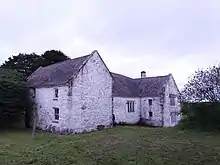Hafotty
Hafotty, Llansadwrn, Anglesey, Wales is a medieval hall house dating from the mid 14th century. Described in the Gwynedd Pevsner as "one of Anglesey's classic small medieval houses", Hafotty is a Grade I listed building and a scheduled monument.
| Hafotty | |
|---|---|
 "One of Anglesey's classic small medieval houses" | |
| Type | House |
| Location | Llansadwrn, Anglesey |
| Coordinates | 53.281°N 4.1581°W |
| Built | 14th century |
| Architectural style(s) | Vernacular |
| Governing body | Privately owned |
Listed Building – Grade I | |
| Official name | Hafotty |
| Designated | 28 May 2003 |
| Reference no. | 81136 |
| Official name | Hafoty Old Farm House |
| Reference no. | AN097 |
Listed Building – Grade II | |
| Official name | Agriculture range at Hafotty |
| Designated | 28 May 2003 |
| Reference no. | 81130 |
 Location of Hafotty in Anglesey | |
History
The original house at Hafotty was built of wood.[1] This house is recorded as "Bodiordderch" ("the house of Iordderch").[2] Anthony Emery dates this wooden house to the second quarter of the 14th century.[3] By 1535, the house was in the possession of Henry Norris, Constable of Beaumaris Castle.[lower-alpha 1][5] By the 16th century, Hafotty had passed to the Bulkeleys, another prominent North Wales family,[lower-alpha 2] and had acquired its present name, meaning summer house, or summer dairy.[1] Cadw records extensions to the house in the 16th century, and its re-casing in stone in the 17th.[5] By the 20th century, Hafotty was in a state of some dereliction,[9] but was restored in the 1970s and again in the early 21st century.[4] The house remains in the possession of the Bulkeleys, although under the care of Cadw, and is occasionally open to the public.[10]
Architecture and description
The Gwynedd Pevsner considers Hafotty "one of Anglesey's classic small medieval houses".[4] Peter Smith, in his Houses of the Welsh Countryside, categorises it as a three-unit hall house and notes that, despite its "relatively modest" size, it was still a "house of status".[11] Built to an H-plan, and constructed of rubble masonry, it is of two-storeys.[5] The interior contains some notable medieval fittings, including fireplaces and window surrounds.[4] Hafotty is a Grade I listed building[5] and a scheduled monument.[12]
Footnotes
- Although Cadw record the house as still being in the possession of Henry Norris in 1535, Pevsner suggests that it had passed to the Bulkeleys by 1511.[4]
- The Bulkeleys are commemorated on the island by the Bulkeley Monument, on the Beaumaris to Llanddona road,[6] and by the Bulkeley Hotel[7] and Bulkeley Terrace, both in the town of Beaumaris.[8]
References
- "Hafoty Medieval House". cadw.gov.wales. Cadw. Retrieved 20 July 2020.
- "Hafoty, Llansadwrn". Coflein. Retrieved 20 July 2020.
- Emery 2008, p. 666.
- Haslam, Orbach & Voelcker 2009, p. 193.
- Cadw. "Hafotty (Grade I) (81136)". National Historic Assets of Wales. Retrieved 20 July 2020.
- Cadw. "Bulkeley Monument (Grade II) (5700)". National Historic Assets of Wales. Retrieved 20 July 2020.
- Cadw. "Bulkeley Hotel (Grade I) (5588)". National Historic Assets of Wales. Retrieved 20 July 2020.
- Cadw. "Bulkeley Terrace (Grade II) (5594)". National Historic Assets of Wales. Retrieved 20 July 2020.
- Charles, Geoff (19 November 1964). "Hafoty, Llansadwrn, the oldest house on Anglesey, in danger because of its unsound state". search.digido.org.uk. National Museum of Wales.
- "Hafoty: Exploring This Beautiful Medieval House". Boltholes & Hideaways. 19 September 2019.
- Smith 1975, p. 42.
- "Hafoty Old Farm House". British Listed Buildings Online. 19 September 2019.
Sources
- Emery, Anthony (2008). Greater Medieval Houses of England and Wales, 1300–1500: East Anglia, Central England, and Wales. Cambridge: Cambridge University Press. ISBN 978-0521581318.
- Haslam, Richard; Orbach, Julian; Voelcker, Adam (2009). Gwynedd. The Buildings of Wales. New Haven, US and London: Yale University Press. ISBN 978-0-300-14169-6. OCLC 1023292902.
- Smith, Peter (1975). Houses of the Welsh Countryside. London: Her Majesty's Stationery Office. ISBN 0-11-700475-8. OCLC 868639211.
External links
 Media related to Hafoty, Llansadwrn at Wikimedia Commons
Media related to Hafoty, Llansadwrn at Wikimedia Commons